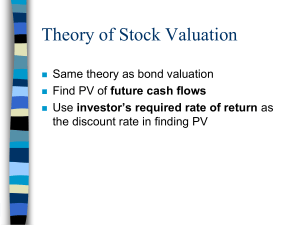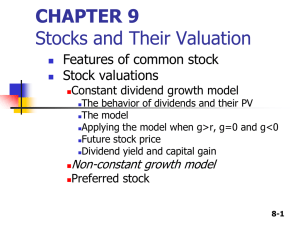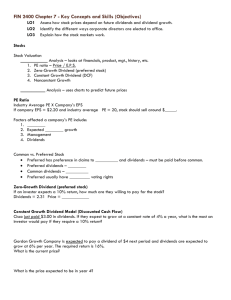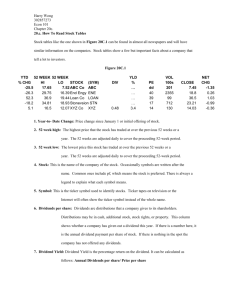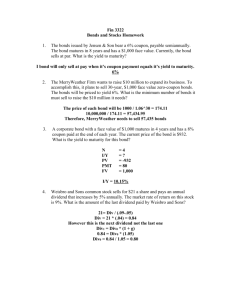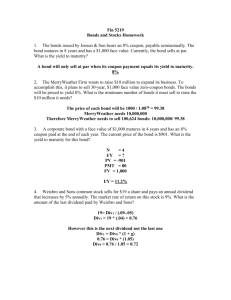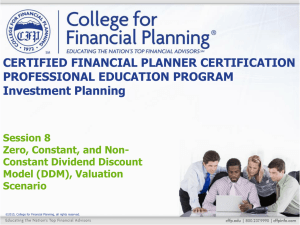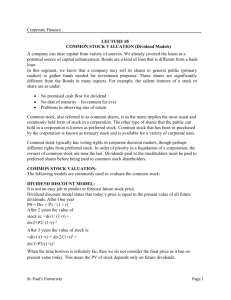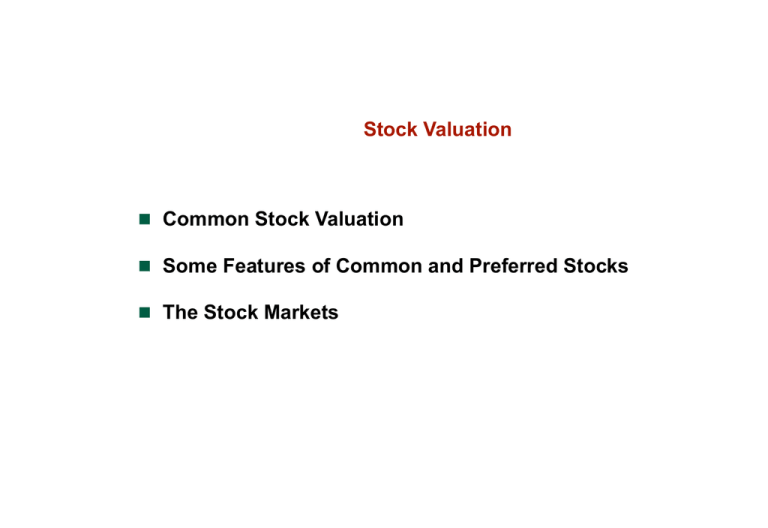
Stock Valuation
Common Stock Valuation
Some Features of Common and Preferred Stocks
The Stock Markets
T2 Common Stock Cash Flows and the Fundamental Theory of Valuation
In 1938, John Burr Williams postulated what has become the
fundamental theory of valuation:
The value of any financial asset equals the present value of all of its
future cash flows.
For common stocks, this implies the following:
P0 =
D1
+
(1 + r)1
P1
and
(1 + r)1
P1 =
D2
(1 + r)1
+
P2
(1 + r)1
substituting for P1 gives
P0 =
P0 =
D1
(1 + r)1
D1
(1 + r)1
+
+
D2
+
(1 + r)2
D2
(1 + r)2
+
P2
(1 + r)2
D3
(1 + r)3
. Continuing to substitute, we obtain
+
D4
(1 + r)4
+ …
T3 Common Stock Valuation: The Zero Growth Case
According to the fundamental theory of value, the value of a
financial asset at any point in time equals the present value of all
future dividends.
If all future dividends are the same, the present value of the
dividend stream constitutes a perpetuity.
The present value of a perpetuity is equal to
C/r or, in this case, D1/r.
Question:
Cooper, Inc. common stock currently pays a $1.00
dividend, which is expected to remain constant
forever. If the required return on Cooper stock is
10%, what should the stock sell for today?
Answer:
P0 = $1/.10 = $10.
Question:
Given no change in the variables, what will the stock
be worth in one year?
T4 Common Stock Valuation: The Zero Growth Case (concluded)
Answer:
One year from now, the value of the stock, P1, must
be equal to the present value of all remaining future
dividends.
Since the dividend is constant, D2 = D1 , and
P1 = D2/r = $1/.10 = $10.
In other words, in the absence of any changes in expected cash
flows (and given a constant discount rate), the price of a nogrowth stock will never change.
Put another way, there is no reason to expect capital gains income
from this stock.
T5 Common Stock Valuation: The Constant Growth Case
In reality, investors generally expect the firm (and the dividends it
pays) to grow over time. How do we value a stock when each dividend
differs than the one preceding it?
As long as the rate of change from one period to the next, g, is
constant, we can apply the growing perpetuity model:
P0 =
P0 =
D1
(1 + r)1
+
D2
(1 + r)2
D0(1 + g)
r-g
=
+
D3
(1 + r)3
D1
r-g
+ …=
D0(1+g)1
(1 + r)1
+
D0(1+g)2
(1 + r)2
D0(1+g)3
+
+ ...
(1 + r)3
.
Now assume that D1 = $1.00, r = 10%, but dividends are expected to
increase by 5% annually. What should the stock sell for today?
T6 Common Stock Valuation: The Constant Growth Case (concluded)
Answer:
The equilibrium value of this constant-growth stock is
D1
$1.00
=
r-g
Question:
= $20
.10 - .05
What would the value of the stock be if the growth rate
were only 3%?
Answer:
D1
$1.00
=
= $14.29.
r-g
.10 - .03
Why does a lower growth rate result in a lower value? Stay tuned.
T7 Stock Price Sensitivity to Dividend Growth, g
Stock price ($)
50
45
D1 = $1
Required return, r, = 12%
40
35
30
25
20
15
10
5
0
2%
4%
6%
8%
10%
Dividend growth
rate, g
T8 Stock Price Sensitivity to Required Return, r
Stock price ($)
100
90
80
D1 = $1
Dividend growth rate, g, = 5%
70
60
50
40
30
20
10
Required return, r
6%
8%
10%
12%
14%
T9 Common Stock Valuation - The Nonconstant Growth Case
For many firms (especially those in new or high-tech industries),
dividends are low and expected to grow rapidly. As product markets
mature, dividends are then expected to slow to some “steady state”
rate. How should stocks such as these be valued?
Answer: We return to the fundamental theory of value - the value
today equals the present value of all future cash flows.
Put another way, the nonconstant growth model suggests that
P0 = present value of dividends in the nonconstant growth period(s)
+ present value of dividends in the “steady state” period.
T10 Quick Quiz -- Part 1 of 3
Suppose a stock has just paid a $5 per share dividend. The dividend is
projected to grow at 5% per year indefinitely. If the required return is 9%,
then the price today is _______ ?
P0 = D1/(r - g)
= $5
(______ )/(______ -______ )
= $5.25/.04
= $131.25 per share
What will the price be in a year?
Pt
= Dt+1/(r - g)
P1 = D___ /(r - g) = ($______
1.05)/(.09 - .05) = $137.8125
By what percentage does P1 exceed P0? Why?
T11 Quick Quiz -- Part 2 of 3
Find the required return:
Suppose a stock has just paid a $5 per share dividend.
The dividend is projected to grow at 5% per year indefinitely.
If the stock sells today for $65 5/8, what is the required return?
P0 = D1/(r - g)
(r - g) = D1/P0
r
= D1/P0 + g
= $5.25/$65.625 + .05
= dividend yield (_____) + capital gain yield (_____)
= ____
T12 Summary of Stock Valuation
I. The General Case
In general, the price today of a share of stock, P0, is the present value of all its future
dividends, D1, D2, D3, . . .
P0 =
D1
(1 + r)1
+
D2
(1 + r)2
+
D3
(1 + r)3
+ …
where r is the required return.
II. Constant Growth Case
If the dividend grows at a steady rate, g, then the price can be written as:
P0 = D1/(r - g)
This result is the dividend growth model.
III. The Required Return
The required return, r, can be written as the sum of two things:
r = D1/P0 + g
where D1/P0 is the dividend yield and g is the capital gain yield.
T13 Sample Stock Quotation from The Wall Street Journal
New York Stock Exchange Composite Transactions
Quotations as of 5 p.m. Eastern Time
Monday, March 28, 1994
52 Weeks
Hi
Yld
Lo
Stock
28 1/2
25 1/2
28 1/4
Sym
Vol
Net
Div
%
PE
100s
Hi
Lo
Close
Chg.
MellonBk pfJ
2.13
8.3
…
27
26
25 3/4
25 3/4 +
1/8
25 5/8
MellonBk pfK
2.05
7.8
…
55
26 1/8
26
26 1/8
…
48 1/4
35 3/4
Melville
MES
1.52
4.0
13
1439
38
37 2/8
37 5/8 +
1/4
12 1/8
9 3/8
MentorIncoFd
MRF
.96
9.5
…
142
10 1/4
10 1/8
10 1/8
…
56 1/2
43 5/8
MercBcpMO
MTL
1.68
3.4
10
219
50
49 1/2
49 3/4 -
1/8
41 1/8
29 7/8
MercStrs
MST
1.02
2.6
17
636
40 5/8
39 5/8
39 7/8 -
1 1/4
39 3/8
28 5/8
Merck
MRK
1.12
3.7
16
21595
30 3/8
30
30 3/8 +
1/4
20 3/8
12 1/8
MercuryFin
MFN
.28f
1.7
30
517
17
16 3/4
16 3/4
…
Source: Reprinted by permission of The Wall Street Journal, ©1991 Dow Jones & Company, Inc.,
March 28, 1994. All Rights Reserved Worldwide.
T14 Quick Quiz -- Part 3 of 3
Suppose a stock has just paid a $5 per share dividend. The
dividend is projected to grow at 10% for the next two
years, the 8% for one year, and then 6% indefinitely. The
required return is 12%. What is the stock’s value?
Time Dividend
0
$ 5.00
1
$ ____
(10% growth)
2
$ ____
(10% growth)
3
$6.534
( __% growth)
4
$6.926
( __% growth)
T15 Quick Quiz -- Part 3 of 3 (concluded)
At time 3, the value of the stock will be:
P3
=
D4/(r - g) = $_____ /(.12 - .06) = $115.434
The value today of the stock is thus:
P0
=
D1/(1 + r) + D2/(1 + r)2 + D3/(1 + r)3 + P3/(1 + r)3
=
$5.5/1.12 + $6.05/1.122 + $6.534/1.123 + $115.434/1.12---
=
$96.55
T16 Solution to Problem
MegaCapital, Inc. just paid a dividend of $2.00 per share on
its stock. The dividends are expected to grow at a constant
6 percent per year indefinitely. If investors require a 13
percent return on MegaCapital stock, what is the current
price? What will the price be in 3 years? In 15 years?
According to the constant growth model,
P0 = D1/(r - g) = $2.00(1.06)/(.13 - .06) = $30.29
If the constant growth model holds, the price of the stock
will grow at g percent per year, so
P3 = P0 x (1 + g)3 = $30.29 x (1.06)3 = $36.07, and
P15 = P0 x (1 + g)15 = $30.29 x (1.06)15 = $72.58.



